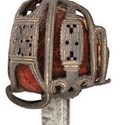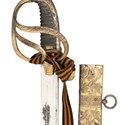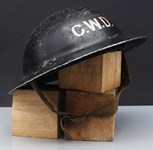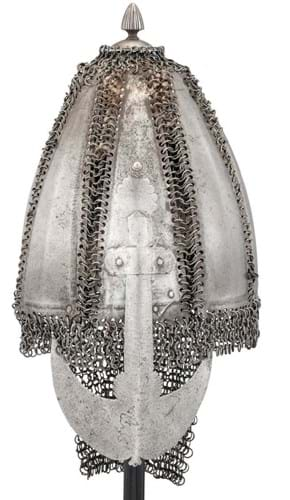
As a teenager, one of his cousins – who was part of a travelling circus troupe – introduced him to the decorative styles of Asia. He immediately became fascinated by the intricacy and the places of manufacture of Asian arms and armour, particularly India.
After joining the family business his large Victorian house became jammed full of acquisitions from auctions, dealers and fellow collectors. His interests branched out into Second World War vehicles and militaria.
A well-known and popular figure at auctions and arms fairs, he extensively researched Hindu arms and armour and travelled to India twice to research locally the items in his collection.

A “very rare” late 15th century south Indian (possible Madurai) sword fetched £17,000 at Olympia Auctions, way over the £600-800 guide. It was bought by a collector. A sword with a similar pommel, symbolising the trimurti (Brama, Vishnu and Maheswara), is illustrated on a sculpture in the Rama Temple, Kumbakonam, built c.1610.
London auction
His family consigned a selection of highlights to west London auctioneer, specialist Thomas Del Mar, as part of the Olympia Auctions (25% buyer’s premium) ‘hub’ in West Kensington – with 87 lots in the December 7 Fine Antique Arms, Armour & Militaria sale comprising the Roy Elvis Collection of Indian Arms and Armour.
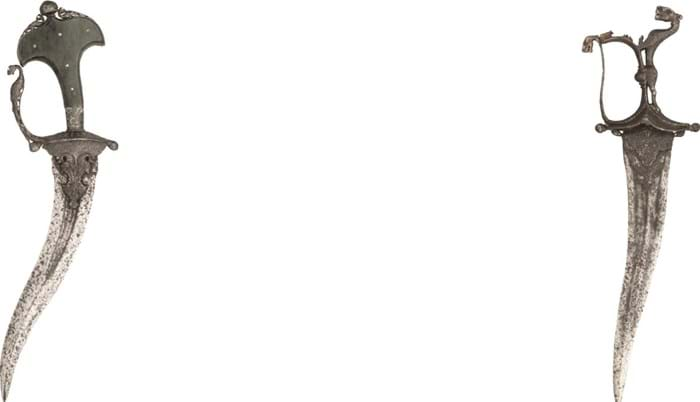
This 16th-17th century South Indian dagger otherwise known as a Khanjarli, shown left, sold to a collector for £10,000 (£600-800 guide), as did a rare 15th-16th century south Indian dagger, known as a Chilanum, pictured right. Regarding the latter, Del Mar noted: “Hilts of this distinctive zoomorphic form are associated with Royal Vijayanagara edged weapons. Around 1620 King Raghunatha Nayaka (c.1600-34) sent a dagger with a lion handle as a gift to the Danish Court in Copenhagen. Another dagger from this group is preserved in the David Collection, Copenhagen.”
Five of the top 10 prices in the auction overall were achieved by items from the collection, which sold for a total of £313,400 (including premium), four times the pre-sale low estimate.
Described here are some of the highlights from the Roy Elvis collection – plus some other standout lots from the auction.
Mughal general
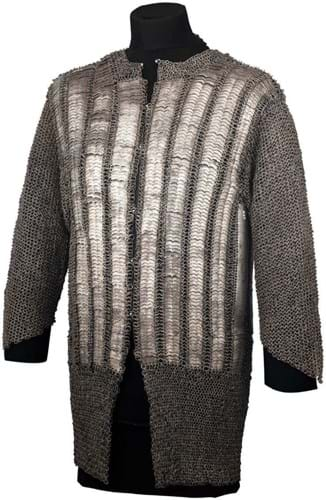
This “very fine and rare” 17th century north Indian mail and plate shirt otherwise known as a zereh bagtar realised £12,000 (estimate £6000-8000) at Olympia Auctions.
They included a “very fine and rare” 17th century north Indian mail and plate shirt otherwise known as a zereh bagtar which realised £12,000 (estimate £6000-8000).
Bought by a collector, it was probably made in Bijapur and was inscribed to Maharaja Anup Singh who reigned from 1669-98. A near identical example, also inscribed to him and with the date samvat 1748 (1691-2AD), is preserved in the Metropolitan Museum of Art, New York.
Singh was a general in the armies of the Mughal emperor Aurangzeb (1618-1707) and led a series of campaigns in the Deccan including battles at Golconda in 1687 and Adoni in 1689. Most of the arms and armour captured by him was then placed in his armoury at Bikaner.
The date on the shirt in the Met example indicates that it must have been taken as booty during one of the Deccan campaigns and the same is likely for this lot, says Del Mar. Both shirts almost certainly originate from Bijapur, the richest and most powerful state in the Deccan until its defeat by Aurangzeb.
The form of this shirt is “notably rare; related examples are also encountered in Eastern Europe and Russia. Mail shirts reinforced with steel or iron plates were probably introduced to India during the early Mughal period by the Ottomans.”
Distinguished provenance
Also included in the December 7 Thomas Del Mar sale was the Collection of a Distinguished Scholar and Collector which showed similar market strength, realising £73,988 (including premium), over twice its estimate. Highlights are shown below.






